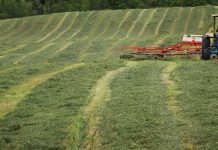Automated activity monitoring system usage continues to grow in the USA. Recent studies estimate that it’s usage on dairy farms has reached 59% of freestall and loose housing-based herds surpassing the number of herds using timed AI protocols. A study from Canada found that 66% of farms found reproduction to be one of their top three challenges with labor for visual estrus detection in heifers listed as one of those challenges.
Many herds are using a combination of timed AI protocols and automated activity monitoring systems. We will discuss how these systems can be complementary to each other in improving a herd’s pregnancy per AI. The usage of automated activity monitoring, or AAM, systems for estrus detection is also gaining popularity for estrus detection in heifers.
Even though heifers have longer durations of visual estrus, they still need to be watched at least three different times per day at approximately an eight-hour spread for the best results of detecting estrus. When using an AAM system heifers also tend to have higher peak activity and a longer duration than cows.
Some AAM systems include in their algorithm for breeding timing if the cow is primiparous or multiparous. While studies vary, multiparous cows have the best conception rates when inseminated within 12 hours of increased activity while primiparous cows had the highest conception when inseminated between 13-16 hours after the onset of increased activity.
AAM systems can work well in heifers, but heifers tend to have a longer time of increased activity than cows causing AAM systems to think they are still in the insemination window when it is past. While there are fewer studies in heifers the best time for insemination is after peak activity or about 16 hours after the onset of increased activity. Overall, using the predictive equations for primiparous cows results in systems having an 84% positive prediction of estrus with a 67% rate of pregnancies per AI. The study found 98% of heifers who were cycling were pregnant after four inseminations using an AAM system.
Users can reduce false estrus detection by looking closer at the magnitude of activity increase. Since heifers generally show a greater increase in activity than cows, the borderline increases that are true estrus in cows are often false estrus in heifers. When heifers are moved to a different farm for breeding, they should be moved at least a month before first insemination and most AAM systems benefit from at least two weeks of baseline data collection on animals before utilizing them for estrus detection. An additional challenge is that heifer barns don’t always have a heated office which may be needed to keep the computer interface working properly in the winter.
A different study from Canada recently looked at linking AAM systems and cow physiology to improve fertility. There was a strong positive correlation between the degree of increase in activity and pregnancy to AI. Cows that expressed over a 300% increase in activity had a 14% higher pregnancy rate than those expressing low estrus activity intensity. Cows with a greater activity intensity also had decreased late embryonic and early fetal losses. This study found that cows with low activity could benefit from receiving GnRH at insemination increasing pregnancies per AI by 9% but pregnancy rates were still lower than cows with high activity.
Cows with higher activity intensity and a longer duration of increased activity had a greater pregnancy rate to sex-sorted semen than low activity intensity cows. While this was also true for conventional semen the increase was much greater for sex-sorted semen. When breeding on a timed AI protocol looking at the intensity of the activity increase may be an additional tool when deciding to use sex-sorted semen or conventional semen on high-producing cows to increase pregnancies per AI.
Automated Activity monitoring systems can also benefit in embryo transfer. The activity rate increase is positively correlated with the number of viable embryos at flushing with the highest activity increases yielding twice as many embryos as a low activity intensity increases. The intensity of activity increase in recipient cows is also positively correlated with ET success, increasing by 11% with high-intensity over low-intensity activity increases. While many technologies benefit dairy operations, AAM systems for both cows and heifers can have positive impacts on pregnancy rates and management decisions.













